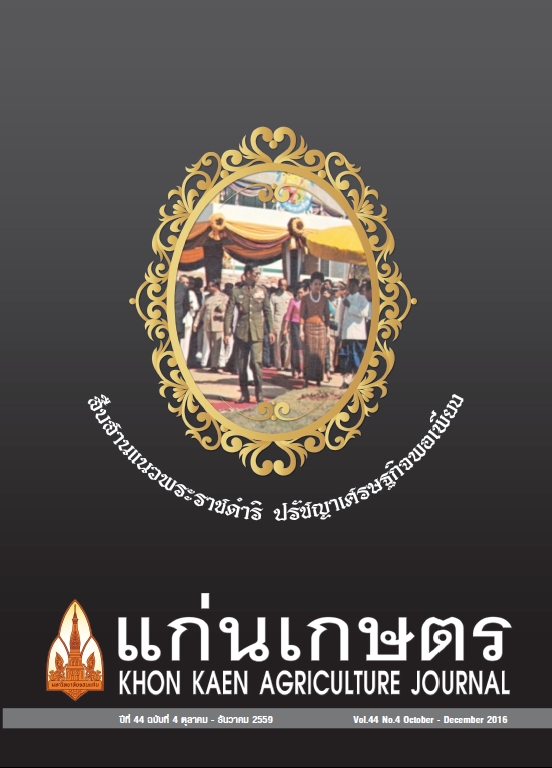ผลสะสมของวัสดุปรับปรุงดินต่อการแจกกระจายของเม็ดดินและการกักเก็บคาร์บอนของดินวารินที่ปลูกมันสำปะหลัง
Main Article Content
บทคัดย่อ
การศึกษาผลสะสมของการใส่วัสดุปรับปรุงดิน ได้แก่ เพอร์ไลต์ ยิปซัม เบนทอไนต์ และหินปูนบดในอัตราละ 200 กก./ไร่ มูลไก่แกลบอัตรา 500 และ 1,000 กก./ไร่ และมูลไก่แกลบอัตรา 500 กก./ไร่ร่วมกับเพอร์ไลต์อัตรา 200 กก./ไร่ในช่วงการเตรียมดินต่อเนื่องเป็นเวลา 4 ปี ที่มีต่อมันสำปะหลังและสมบัติดินซึ่งดำเนินการทดลองในชุดดินวาริน ในจังหวัดนครราชสีมา พบว่า การใส่มูลไก่แกลบ 500 กก./ไร่ ร่วมกับเพอร์ไลต์ 200 กก./ไร่ ให้ผลผลิตหัวมันสำปะหลังสด ผลผลิตแป้งและชีวมวลเหนือดินสูงที่สุดอย่างมีนัยสำคัญทางสถิติเท่ากับ 7.53, 2.22 และ 1.35 ตัน/ไร่ ตามลำดับ ซึ่งไม่แตกต่างจากการใส่มูลไก่แกลบในอัตรา 500 หรือ 1000 กก./ไร่ ขณะที่การใส่เพอร์ไลต์ ยิปซัม และเบนทอไนต์กลับให้ผลไม่แตกต่างจากการไม่ใส่วัสดุปรับปรุงดินทางสถิติ อย่างไรก็ตาม ตำรับควบคุมมีแนวโน้มให้ผลผลิตและผลผลิตแป้งต่ำที่สุดเท่ากับ 3.31 และ 0.88 ตัน/ไร่ ตามลำดับ วัสดุปรับปรุงดินเหล่านี้ยังส่งผลให้สมบัติทางเคมีของดินบนดีขึ้นเมื่อเปรียบเทียบกับไม่ใส่วัสดุปรับปรุงดินอย่างมีนัยสำคัญทางสถิติ โดยหินปูนบดลดความเป็นกรดของดินได้ดีที่สุด (pH 6.8) ส่วนการใส่มูลไก่แกลบ 1000 กก./ไร่ ให้ความจุแลกเปลี่ยนแคตไอออน (6.23 เซนติโมล/กก.) ปริมาณอินทรียวัตถุ (5.75 ก./กก.) และโพแทสเซียมที่เป็นประโยชน์ของดิน (66.6 มก./กก.) สูงที่สุดรวมถึงการกักเก็บคาร์บอนอินทรีย์ (0.43 กก.คาร์บอน/ตร.ม.) ชุดดินวารินที่ทำการใส่วัสดุปรับปรุงดินเหล่านี้อย่างต่อเนื่องพบว่า เม็ดดินส่วนใหญ่อยู่ในขนาด 0.25-0.1 มม. โดยคาร์บอนอินทรีย์ส่วนใหญ่ถูกกักเก็บอยู่ในเม็ดดินขนาด 1-0.5 มม. มีค่าอยู่ในพิสัย 0.12-2.63 กก.คาร์บอน/ตร.ม. การใส่วัสดุอนินทรีย์ปรับปรุงดินมีแนวโน้มให้เม็ดดินกักเก็บคาร์บอนอินทรีย์ไว้มากกว่าการใส่วัสดุอินทรีย์ ส่วนการใส่ร่วมกันทำให้การกักเก็บคาร์บอนอินทรีย์ลดลง
Article Details

อนุญาตภายใต้เงื่อนไข Creative Commons Attribution-NonCommercial-NoDerivatives 4.0 International License.
เอกสารอ้างอิง
Angers, D.A., A.N. Dayegamiye, and H. Antoun. 2007. Soil aggregation and biochemical properties follow-ing the application of fresh and composted organic amendments. Soil Sci. Soc. Am. J. 72: 160-166.
Barthes, B., A. Azontonde, B.Z. Boli, C. Prat, and E. Roose. 1999. Field-scale run-off and erosion in relation to topsoil aggregate stability in three tropical regions (Benin, Cameroon, Mexico). Eur. J. Soil Sci. 51: 485-496.
Boix-Fayos, C., A. Calvo-Cases, A.C. Imeson, and M.D. Soriano-Soto. 2001. Influence of soil properties on the aggregation of some Mediterranean soils and the use of aggregate size and stability as land degradation indicators. Catena. 44: 47-67.
Brady, N.C., and R.R. Weil. 2008. The Nature and Properties of Soils. 14th ed. Prentice Hall, New Jersey.
Bronick, C.J., and R. Lal. 2005. Soil structure and management: a review. Geoderma. 124: 3-22.
Caravaca, F., A. Lax, and J. Albaladejo. 2004. Aggregate stability and carbon characteristics of particle-size fractions in cultivated and forested soils of semiarid Spain. Soil Till. Res. 78: 83-90.
De Boodt, M., and D. Gabriels. 1973. The effect of synthetic soil conditioners on the physical fertility of loamy soils and in particular on the germination of sugar beets. Comptes-Rendus de la Semaine d’ Etude Sol et Fertilisation, Gembloux, Belgium. 30: 106-116.
Emami, H., and A. R. Astaraei. 2012. Effect of organic and inorganic amendments on parameters of water retention curve, bulk density and aggregate diameter of a saline-sodic soil. J. Agr. Sci. Tech.14: 1625-1636.
Jastrow, J.D., R. M. Miller, and J. Lussenhop. 1998. Contributions of interacting biological mechanisms to soil aggregate stabilization in restored prairie. Soil Biol. Biochem. 30: 905-916.
Leenheer, L., and M. Boodt. 1959. Determination of aggregate stability by the change in mean weight diameter. Meded. Landb. Gent. 24: 290-351.
Mbagwu, J.S.C. 1989. Influence of cattle feedlot manure on aggregate stability, plastic limit and water retentions of three soils in north central Italy. Biol. Wastes. 28: 257-269.
Mbagwu, J.S.C., and P. Bazzoffi. 1988. Stability of microaggregates as influenced by antecedent moisture content, organic waste amendment and wetting and drying cycles. Catena. 15: 565-576.
National Soil Survey Center. 1996. Soil Survey Laboratory Method Manual. Soil Survey Investigation Report No. 42, Version 3.0. National Resources Conservation Service, United States Department of Agriculture.
Ogunwole, J. 2008. Soil aggregate characteristics and organic carbon concentration after 45 annual applications of manure and inorganic fertilizer. Biol. Agric. Hortic. 25: 223-233.
Sanchez, P.A. 1976. Properties and Management of Soils in the Tropics. John Wiley and Sons, Inc., New York.
Shamshuddin, J., C.I. Fauziah, and L.C. Bell. 2009. Soil solution properties and yield of corn and groundnut grown on ultisols as affected by dolomitic limestone and gypsum applications. Malays. J. Soil Sci. 13: 1-12.
Simansky, V. 2012. Soil structure stability and distribution of carbon in water-stable aggregates in different tilled and fertilized Haplic Luvisol. Acta Agric. Silvic. Mendel. Brun. 3: 173–178.
Six, J., E.T. Elliott, K. Paustian, and J.W. Doran. 1999. Aggregate and soil organic matter dynamics under conventional and no-tillage systems. Soil Sci. Soc. Am. J. 63: 1350-1358.
Six, J., E.T. Elliott, and K. Paustian. 2004. A history of research on the link between (micro) aggregates, soil biota, and soil organic matter dynamics. Soil Till. Res. 79: 7-31.
Von Uxekull, H.R. 1986. Efficient Fertilizer Use in Acid Upland Soils of the Humid Tropics. FAO Fertilizer and Plant Nutrition Bulletin No. 10, Singapore.
Zhang, X.A, R.E. Wang, and S.H. Wu. 2012. Soil Aggregate Distribution of Soil under Different Soil Management Practices. State Key Laboratory of Forest and Soil Ecology, Institute of Applied Ecology, Chinese Academy of Sciences, Shenyang 110164, China.


